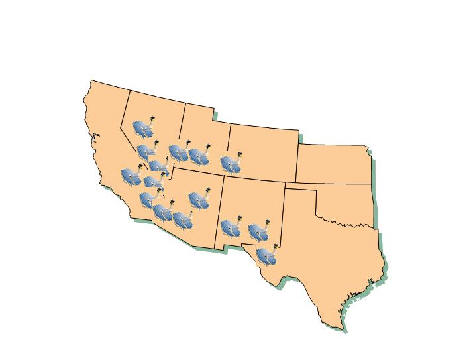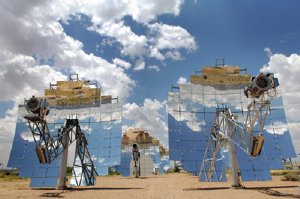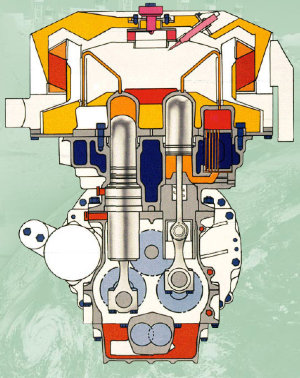World's largest solar installation to use Stirling engine technology
20-year purchase agreement between Southern California Edison and Stirling Energy Systems, Inc. will result in 20,000+ dish array, covering 4,500 acres, and capable of generating 500 MW -- more electricity than all other present U.S. solar projects combined.
"We operate in a competitive marketplace. While [for confidentiality reasons] we cannot give out precise dollar amounts for how much these installations will cost, we believe the final agreement is very beneficial to our customers. We do not need any subsidies to make this work." -- Gil Alexander (Aug. 11, 2005)
Spokesperson, Southern California Edison
by
Sterling D. Allan
Copyright © 2005
Pure Energy Systems News
ROSEMEAD, CA, USA -- A Stirling engine is commonly referred to as an
"external combustion engine" in contrast to the "internal combustion
engines" found in most vehicles. Combine a Stirling engine with solar as
the source of heat, and you have a highly efficient means of converting
solar power into usable energy.
That is what Stirling Energy Systems has been perfecting for the past 20
years.
|
Now they are ready to go big-time, with an agreement signed Tuesday with
Edison International (NYSE:EIX) a subsidiary of Southern California Edison (SCE),
the nation's leading purchaser of renewable energy.
On Tuesday they announced an agreement that could result in construction of
a massive, 4,500-acre solar generating station in Southern California. This
comes to around seven square miles, with a perimeter of nearly 30 miles.
The completed power station would be the world's largest solar facility,
capable of producing more electricity than all other currently-operating
U.S. solar projects combined.
This signing was a day after President George W. Bush visited their Sandia
National Laboratories installation where they have six prototypes in
operation, having chosen this location as his backdrop for the signing of
the Energy bill.
Signed Tuesday, the 20-year power purchase agreement, which is subject to
California Public Utilities Commission approval, calls for development of a
500-megawatt (MW) solar project 70 miles northeast of Los Angeles using
innovative Stirling-engine/solar-dish technology. This is enough power to
run approximately half a million homes.
According to the California Energy Commission, there are 966 power plants in
California that generate more than 0.1 MW. Of those, a 500 MW plant would
be in the top 3% for size.
The agreement includes an option to expand the project to 850 MW.
Initially, Stirling would build a one-MW test facility using 40 of the
company’s 37-foot-diameter dish assemblies. (Each dish generates 25
kilowatts.) This phase is slated to be completed in the first quarter of
2007. One of the 40-unit arrays capable of a 1 MW output, will be dubbed a
"solar power group" and will be the basis of modular calculations for future
installations.
Subsequently, the 20,000-dish array is to be constructed near Victorville,
California, during a four-year period, starting in early 2008. If Edison
opts for the additional 350 MW installation, that will take two more years,
and will bring the total number of panels to 34,000.
“At a time of rising fossil-fuel costs and increased concern about greenhouse-gas emissions, the Stirling project would provide enough clean power to serve 278,000 homes for an entire year,” said SCE Chairman John Bryson. “Edison is committed to facilitating development of new, environmentally sensitive, renewable energy technologies to meet the growing demand for electricity here and throughout the U.S.”
“We are especially pleased about the financial benefits of this agreement
for our customers and the state,” said Alan Fohrer, SCE chief executive
officer. “The contract requires no state subsidy and provides favorable
pricing for ratepayers because tests have shown the Stirling dish technology
can produce electricity at significantly lower costs than other solar
technologies.”
Gil Alexander, spokesperson for Southern California Edison said, "We operate
in a competitive marketplace. While [for confidentiality reasons] we cannot
give out precise dollar amounts for how much these installations will cost,
we believe the final agreement is very beneficial to our customers. We do
not need any subsidies to make this work."
Pioneering Stirling-solar to be Commercially Viable
Although Stirling dish technology has been successfully tested for 20
years, the SCE-Stirling project represents its first major application in
the commercial electricity-generation field. Experimental models of the
Stirling dish technology have undergone more than 26,000 hours of successful
solar operation. A six-dish model Stirling power project is currently
operating at the Sandia National Laboratories in Albuquerque, New Mexico.
However, this isn't the first commercial application of Stirling engine
technology. For instance, Swedish submarines use Stirling engines for
propulsion. (ref)
How It Works
The Stirling dish technology converts thermal energy to electricity by
using a mirror array to focus the sun’s rays on the receiver end of a
Stirling engine. Each panel tracks azimuth and elevation to keep the sun’s
rays focused at greatest intensity possible.
The internal side of the receiver then heats hydrogen gas which expands. The
pressure created by the expanding gas drives a piston, crankshaft, and
drive-shaft assembly much like those found in internal combustion engines
but without igniting the gas. The drive shaft turns a small electricity
generator. The entire energy-conversion process takes place within a
canister the size of an oil barrel. The process requires no water and the
engine is emission-free.
Comparison to Other Solar Technologies
Tests conducted by SCE and the Sandia National Laboratories have shown
that the Stirling dish technology is almost twice as efficient as other
solar technologies. These include parabolic troughs which use the sun’s
heat to create steam that drives turbines similar to those found in
conventional power plants, and photovoltaic cells which convert sunlight
directly into electricity by means of semiconducting materials like those
found in computer chips.
Additional Applications
While the number of potential applications for this technology is huge,
in the near term Stirling Energy Systems will be keeping their focus on
these utility installations.
Related Facts
- SCE procured more than 13,000 gigawatt-hours* of renewable energy in 2004, more than any U.S. utility and enough to power almost two million homes for an entire year.
- In 2004, more than 18% of the power SCE delivered to the 13 million Californians it serves came from renewable energy sources.
- SCE’s current renewable portfolio can deliver 2,588 MW of electricity,
including
- 1,021 MW from wind
- 892 MW from geothermal
- 354 MW from solar
- 226 MW from biomass
- 95 MW from small hydro. - Within the next several weeks, SCE will launch its ninth request for offers by independent power producers in the past three years and the third exclusively for proposals by renewable energy providers. These open, competitive solicitations have resulted in 12 new renewable contracts with a maximum potential capacity of 1,630 MW.
*A gigawatt equals one billion watts.
About Southern California Edison
An Edison International (NYSE:EIX) company, Southern California Edison is one of the nation's largest electric utilities, serving a population of more than 13 million. That includes 4.6 million customer accounts in a 50,000-square-mile service area within central, coastal and Southern California.
About Stirling Energy Systems
According to their
website, Stirling Energy Systems (SES) is a systems integration and
project management company that is developing equipment for utility-scale
renewable energy power plants and distributed electric generating systems ("gensets").
For establishing solar power plants, SES is teamed with Kockums Submarine
Systems, NASA-Glenn Laboratories, the U.S. Department of Energy (DOE), and
The Boeing Company.
SES is positioned to become a premier worldwide renewable-energy-technology
company, serving the global demand for renewable electric generating
technologies through the commercialization of its own Stirling cycle engine
technology for solar and genset applications. In the future, SES will also
be participating in the biogas, biogas, and hydrogen markets.
Besides the Sandia location, SES solar units are installed in Huntington
Beach; UNLV, Nevada; and near Johannesburg, South Africa, which is the
largest power plant in Africa. Stirling solar generator arrays had been
installed in Washington state, but are not there any longer. The company is
in discussion with parties from a number of other locations.


Installations, actual and potential, as of
August, 2005.
Source:
http://stirlingenergy.com
Beginnings with Ford Motor Company
 Stirling
Energy Systems CEO, Bruce Osborn, said that this technology using the
Stirling engine actually had its beginning 25 years ago when he worked for
the Ford Motor Company. They were investigating the technology, and he was
part of that project. In the interim, the technology changed hands several
times until it came under Stirling Engine Systems.
Stirling
Energy Systems CEO, Bruce Osborn, said that this technology using the
Stirling engine actually had its beginning 25 years ago when he worked for
the Ford Motor Company. They were investigating the technology, and he was
part of that project. In the interim, the technology changed hands several
times until it came under Stirling Engine Systems.
The support system for each 37-foot-diameter Stirling-solar unit is very
similar to the chassis of an automobile. Other similarities can be found as
well.
"The system is very conducive to mass production," said Osborn.
"We're looking at this as a historic event for solar energy -- a milestone,"
he said. This will be the first large-scale, grid-level installation of
solar technology anywhere in the world.
"We're happy to be the first ones to do this."
Osborn also noted that SES holds the world's record for efficiently
converting sunlight to usable energy.
Their biggest problem will be to keep from growing too fast, he said. There
will be many metamorphoses as they transform from a small company into a
large one. "It is very tempting" to chase after some of the other myriad of
applications, "but we have to keep our focus."
# # #
SOURCES
- BusinessWire press release, Aug. 9, 2005
- http://www.edisonnews.com
- http://www.stirlingenergy.com
- Phone interview with Gil Alexander, Spokesperson, Southern California Edison; Aug. 11, 2005
- Phone interview with Bruce Osborn, CEO, Stirling Energy Systems; Aug. 11, 2005
- http://usinfo.state.gov/gi/Archive/2005/Aug/09-544662.html?chanlid=globalissues - Bush tours Sandia facility.
- http://www.southbendtribune.com/stories/2005/08/09/nation.20050809... - another photo of President Bush
CONTACTS
Stirling Engine Systems
http://stirlingenergy.com/
Bruce Osborn, CEO
or Robert Liden, Executive VP, General Manager
Edison International
Corporate Communications, 626-302-2255
www.edisonnews.com
Originally published at: http://pesn.com/2005/08/11/9600147_Edison_Stirling_largest_solar/







